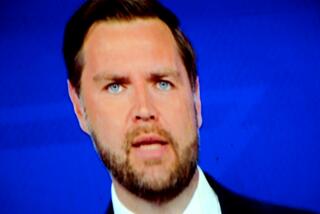The VP Selection Process Is Flawed, and It Shows
In the first and, regrettably, only debate between the candidates for vice president, Sen. Dan Quayle came under unprecedented scrutiny concerning his qualifications.
The questions, of course, had nothing to do with his ability to discharge the duties of the office he is seeking--the ceremonial role of serving as the presiding officer of the Senate and casting an infrequent tie-breaking vote. Rather, they focused on his potential to be a future President. Most Americans would accept this as the really important premise. But if they are now critical on the question of his ability to lead, should they not also question the process by which Quayle, and all vice presidential candidates, are chosen? I believe it is this process that is seriously flawed.
Under the Constitution, the framers provided for a means of selection that clearly presumed the person chosen would be presidential timber. After a majority of the votes in the electoral college established who had won the presidency, the runner-up was to be declared the vice president. It was only after a tie vote in the electoral college in 1800 gave us President Thomas Jefferson and Vice President Aaron Burr that the 12th Amendment was proposed and finally ratified on June 15, 1804. It provided, of course, that the electors should make distinct lists of all persons voted for as President and of all those voted for as vice president.
There is nothing then in constitutional history to warrant the conclusion that the vice presidency is simply merged into the office of the presidency itself. Nevertheless, this seems to be the political theory that supports giving the presidential nominee the unfettered choice of another constitutional officer, the vice president.
If we are indeed selecting a potential President when we vote for a vice president on Nov. 8, the present process of selecting the nominees should be drastically revised. There are several approaches that could be used. A candidate for his partyâs nomination could submit himself to the primary and caucus voters. However, when a former governor of Massachusetts, Endicott Peabody, formally announced a few years ago that he was running for vice president, he was written off as a political eccentricity.
No, I believe that this is a case where the office should seek the man. Yet who, if not primary or caucus voters, should seek out a vice president? Normally there is at least six weeks between the last state primary and the earliest of the two party conventions. More often than not, prospective presidential nominees have been identified much earlier. In the case of George Bush, five months elapsed between Super Tuesday, when he clenched the nomination, and the GOP convention.
Clearly there would be ample time for the unfolding of a much more public and rational process of selection than the type of covert operation that led to Quayleâs surprise choice. His sudden appearance as he came bounding out of the crowd along the banks of the Mississippi was as surreal as the figure that explodes out of a giant cake at a surprise birthday party. Good political theater for a day perhaps. But then, as the hapless junior senator discovered, the fun and games were over and the pummeling began.
Over five months of a formal primary season and for virtually three years before, the American people have the opportunity to examine and then reflect on the strength and weaknesses of prospective presidential candidates. It would not be too much to give them five or six weeks to sift through some choices in selecting their partyâs nominee for vice president.
After the selection of a presidential nominee had been assured, the same people who made up about 15% of the last Democratic convention, the so-called âsuper delegates,â could convene and begin a screening process. Although there is nothing comparable in the GOP today, I would invite them to change their rules and confer similar status on a number of the party hierarchy and Republican office holders--senators, representatives, governors and mayors. From groups as large as this, even nominally closed sessions would yield plenty of clues about leading contenders for the vice presidency. At least three or four weeks before the convention itself, a short list of three would be publicly announced. The investigatory process would then be shifted to the public domain, and from barbershop to barroom the assets and liabilities of each potential nominee would be debated as public scrutiny intensified.
The convention would then make the final choice. This proposal would, at most, involve a change in party rules and procedure. It would furnish both the peer review and public involvement in the process that are now lacking. A constitutional office belongs to the people. It is not the proprietary interest of an individual, even one as prominent and powerful as a presidential candidate. The present system is in disrepair and needs amending.
More to Read
Get the L.A. Times Politics newsletter
Deeply reported insights into legislation, politics and policy from Sacramento, Washington and beyond. In your inbox three times per week.
You may occasionally receive promotional content from the Los Angeles Times.










